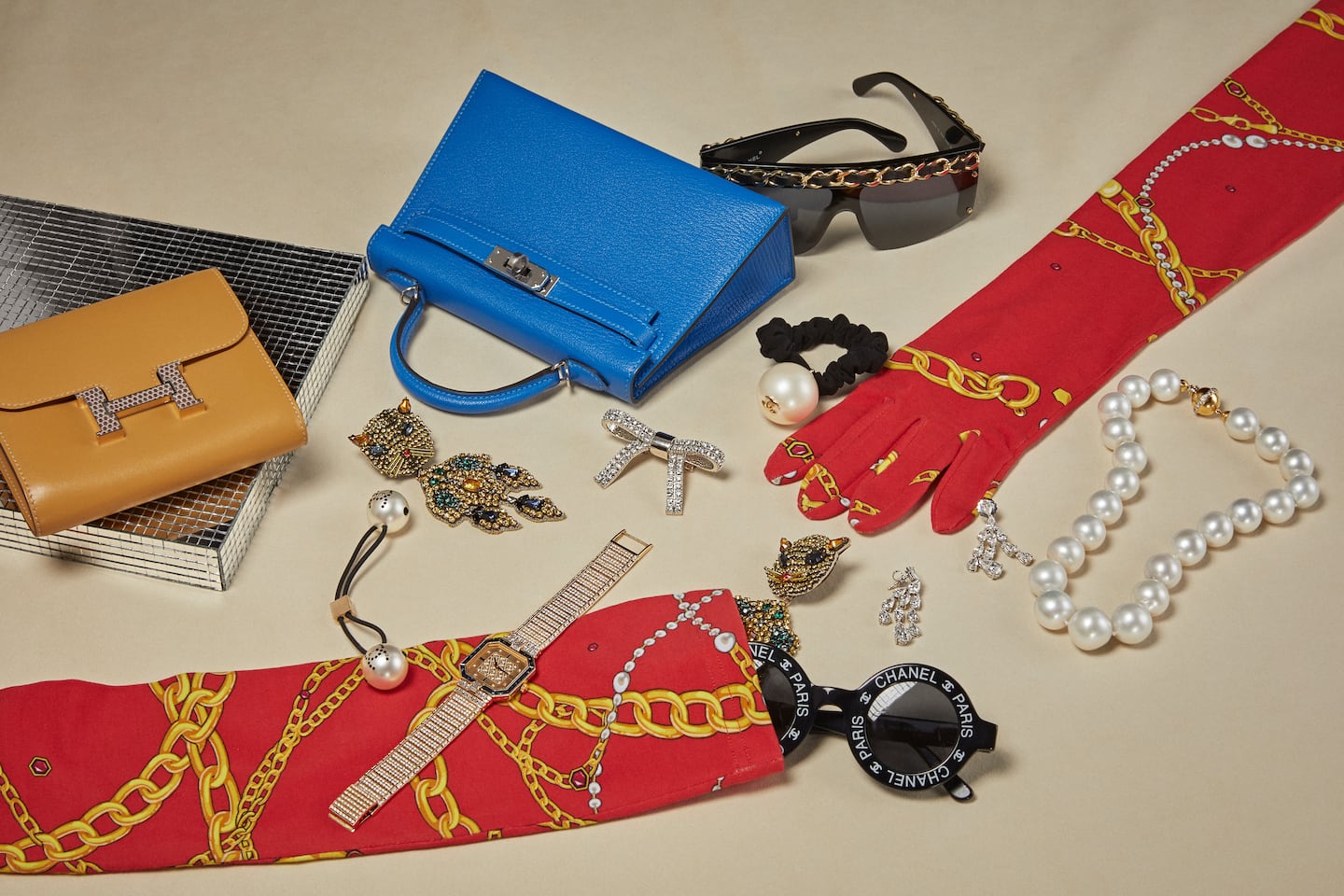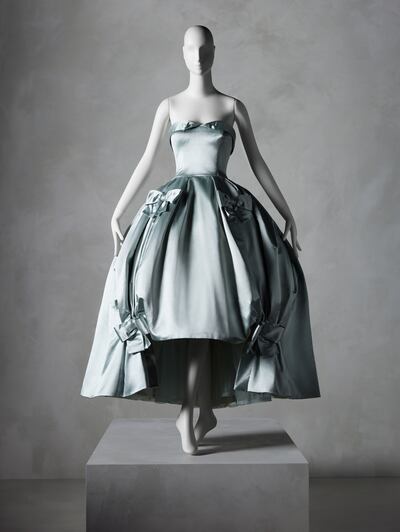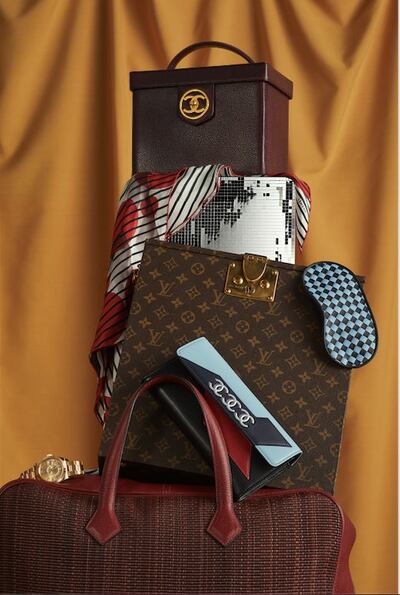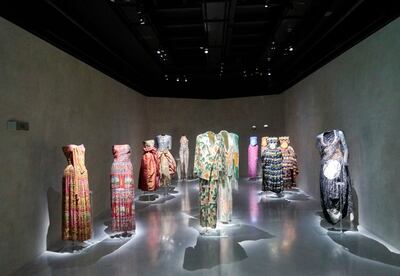
The Business of Fashion
Agenda-setting intelligence, analysis and advice for the global fashion community.

Agenda-setting intelligence, analysis and advice for the global fashion community.

NEW YORK, United States — Sandy Schreier has a closet that fashion enthusiasts would gladly take out a second mortgage for.
There’s a delicate silk chiffon evening dress by Pierre Balmain from 1957 and a dramatically-tufted satin ball gown custom-made by Christian Dior from the same time period, perfect for a Disney princess. There’s an enormous headpiece made of colourful butterflies by the couturier Philip Treacy from 2003, and a purple velvet asymmetrical hat made by Jeanne Lanvin in 1915, trimmed with mink and dainty flowers.
She also owns Valentino outfits that belonged to Jacqueline Kennedy Onassis and a silver Roberto Rojas mini dress that Twiggy wore for a 1967 Vogue photoshoot.
Schreier is from Detroit and grew up surrounded by wealthy families with last names like Ford, Dodge, and Firestone, who had prospered from the city’s automotive industry boom. She had access to their closets, receiving gifts from them as a young girl and later acquiring pieces from estate sales. She has since amassed what is widely considered the largest private fashion collection in the US.
ADVERTISEMENT
Some of those pieces will go on display at the Metropolitan Museum of Art next week, part of a donation of 165 items that Schreier promised to the institution’s Costume Institute last November.

An evening dress by Christian Dior. | Photo: Courtesy
The Met was lucky to nab Schreier’s treasures. Collecting fashion used to be a fringe pursuit. Rare pieces were typically sold at heritage auction houses, purchased by a handful of other wealthy collectors or mostly-obscure museums specialising in textiles or costumes.
But the race to buy rare collectables is heating up. These days, the Met is competing with a score of rival museums, venture-backed startups and wealthy consumers alike. All are clamouring to get their hands on fashion collectables, and have easier access than ever to rare fashion pieces thanks to a host of new websites and apps.
“We’re often competing against private individuals for the same pieces,” said Jessica Regan, associate curator at the Costume Institute.
Prices for fashion collectables have ballooned by 400 percent since 2014, according to data published by Bloomberg from Invaluable, a digital marketplace that represents about 5,000 auction houses. A Raf Simons camo bomber jacket, that retailed for a few thousand dollars in 2001, can go for as high as $42,000. At a Sotheby's auction last month, a grey wool coat from Margiela that was estimated at €4,000 (about $4,430) sold for €32,500 (about $36,000).
And though you still need plenty of cash to join the ranks of fashion collectors — a museum-worthy vintage Schiaparelli couture dress might fetch $45,000 — the landscape has changed drastically. A growing consensus views fashion can be collected and displayed much like art or antiques, boosting demand from museums and serious collectors.
Prominent fashion collectors, like Vogue's Hamish Bowles or socialite Daphne Guinness, have been joined by scores of young men and women who chase after original pieces from Raf Simons, Helmut Lang, Tom Ford for Gucci, and Hedi Slimane for Dior and Yves Saint Laurent, said David Casavant, 29, who rents items from his extensive collection to celebrities like Solange, Lorde, Kim Kardashian, and Travis Scott. Casavant got his start as a fashion collector at the age of 13 and used money he inherited to comb eBay for used fashion. Newly wealthy shoppers in emerging markets, particularly China, are investing in vintage pieces to fill out their closets and have the funds to patch the price as well.
ADVERTISEMENT
“There are tons of young guys who are really into collecting fashion, and they even have their own private groups on Facebook or Instagram,” Casavant said. “I attribute this to celebrities like Kayne or Pharrell. Decades ago, celebrities never wore ‘used clothes’ but Kanye was really into vintage and it’s just totally snowballed from there.”
Fashion has also turned nostalgic, said Marie Blanchet, chief executive of William Vintage, a popular luxury vintage destination in London.
“Older collectables are really in style right now,” particularly with Gen Z, she said.
The Players in the Game
These days, per Blanchet, some of the most sought-after pieces amongst collectors and museums alike include designs by John Galliano, Yves Saint Laurent for Dior, couture from Givenchy, Tom Ford for Gucci, and any work from by Cristobal Balenciaga and Gabrielle Chanel.
But there's also been a growing appetite for neo-vintage collectables from the 90s and 2000s, which Dominik Halas, a 26-year-old fashion collector in New York City attributes to the influences of Martin Margiela on Demna Gvasalia.
"It used to be much more runway, glamour red-carpet focused, but over the last five to seven years there's been increased interest in collecting avante-garde," said Halas, who collects Yohji Yamamoto, Comme des Garçons and Helmut Lang. "This style has opened collecting up to younger audiences."
It used to be much more runway, glamour red-carpet focused, but over the last five to seven years there's been increased interest in collecting avante-garde.
Pieces from some of these designers are relatively rare, and the e-commerce space for buying and selling them has grown more competitive.
ADVERTISEMENT
“Pristine quality is hard to find,” said Noah Wunsch, head of e-commerce at Sotheby’s, which began holding fashion auctions regularly online last year to attract wealthy young customers. “The attitude amongst sneaker or streetwear collectors today is to keep and store them, but that hasn’t always been the case.”
Heritage auction houses are stepping up their fashion offerings to keep up with the newer entrants. Sotheby's has begun holding regular auctions for fashion collectables like Guo Pei and Martin Margiela. A digital auction for rare Chanel will go live later this month.
“There are a lot of people in the category right now, so we want to play in it in a bigger way,” Wunsch said. “Our mission statement is to be where collectors gather, and collectors are evolving in the age of social media.”
The site 1stdibs has about 200 fashion sellers from across the globe. 1stdibs, which also sells furniture and other rare and antique items, woos sellers with perks like discounted shipping and analytics. Dealers are vetted before they join.
“We are a giant marketing machine for these sellers,” said Cristina Miller, chief commercial officer at 1stdibs. “We’re broadening the audience to find customers they wouldn’t be able to reach.”
1stdibs expects $300 million in goods to be sold on its site this year, though fashion is one of its smaller categories. The site is one of the oldest of its kind, launching in 2001, but it's far from the only game in town. Farfetch and Matchesfashion offer rare, one-of-a-kind fashion from sellers like William Vintage. Resale sites like Grailed and Vestiaire Collective have become destinations for collectable fashion too. On Depop, a social media platform that's become beloved by Gen Z-ers who covet vintage, users like 20-year-old Olivia Haroutounian, whose mom owned a vintage store in Houston, sell teens vintage Chanel suits from the 80s and rare Jean Paul Gaultier dresses.
The RealReal started a trust-and-estates division in 2017, where employees visit collectors’ homes in search of treasures. They’ve uncovered a custom crocodile Birkin, listed for $36,000, and vintage caviar spoons by Claude Lalanne, selling for $8,900, among other finds.

Fashion collectibles selling on The RealReal. | Source: Courtesy
Karin Dillie, director of the division, told BoF she spends her days burrowing through secret closets in New York City and mansions in California. She has combed through the estate of a celebrity who had three walk-in closets containing vintage accessories from Dior, Hermes and Chanel. One collector’s estate included 75 Chanel suits and a fashion editor from the New York area collected Gucci loafers in every shade of the rainbow.
To nab some treasures, it certainly helps to have deep connections. Blanchet, from William Vintage, has an extensive rolodex from making connections with collectors at her previous job, working as head of vintage for Vestiaire Collective. In February, for example, she heard from a contact who said she had “some” McQueen pieces to sell, which ended up being quite the understatement.
“She had some of the most amazing and important McQueen pieces I had ever seen, and they were everywhere; stored under the bed, in drawers,” Blanchet said. “The most amazing pieces often come with the strangest stories. Everyone wants a piece of fashion history, so you really need to be looking everywhere to build the right network.”
Private collectors are now torn about where to turn when they want to sell their wares. Cameron Silver, a fashion collector who owns the Los Angeles vintage store Decades, was ready to part with his rare pieces from Jean Paul Gaultier, Thom Browne, and Tom Ford for Gucci that were taking up an entire bedroom and an offsite storage unit. He donated and sold them to Fashion Institute of Technology, Museum of Fine Arts, Boston and the Los Angeles County Museum of Art.
Silver said there is a certain fulfilment that collectors feel when their taste is deemed museum-worthy. But he also understands the appeal of selling elsewhere — and it’s not just about the money.
Everyone wants a piece of fashion history, so you really need to be looking everywhere to build the right network.
"The real circular economy is passing an icon onto the next. The story will continue," Silver said. "A woman named Maria that I met in LA had a rare black lace Tom Ford dress that she was adamant about selling because it was a dress she'd met her husband in, and she wanted someone else to meet their husband in it. Sometimes, it can feel static, knowing something will sit in a museum."
Wunsch argued that fashion collectors are better off selling their items through Sotheby’s instead of a destination like The RealReal because it offers a more competitive commission rate: 15 percent, as opposed to The RealReal, which can charge a commission of up to 30 percent for high value items.
The newest competitors for vintage finds though are investment startups like Rally Rd, which sell shares of rare collectables. A blue lizard Birkin bag that once belonged to Cardi B., for example, is valued at $60,000, with the platform selling 2,000 shares for $30 each. Rob Petrozzo, one of Rally Rd's co-founders, said his start-up approaches private collectors with the promise of offering fast cash.
“Something could sit ... for seven or eight months, potentially, until it’s found that one buyer, but our whole process takes 15 days,” said Petrozzo. “Private collectors looking to sell know they can come to us and get it done really quickly.”
How to Face Competition
Museums can be at a disadvantage when facing off against Rally Rd, 1stdibs or The RealReal. They often rely on donations and aren’t flush with millions of dollars in venture-capital funding.
They face competition on their own turf too. Many more institutions are introducing fashion exhibits and buying collectables as interest in the field surges. The Met’s Catholic fashion exhibit from 2018 was the museum’s most-visited exhibit ever, with a record 1.6 million visitors. The National Museum of Women in the Arts in Washington D.C., the Now Gallery in London, and the McNay Art Museum in San Antonio are just some of the museums that have started hosting fashion exhibits.
Brands like Yves Saint Laurent and Armani now have their own museums, and many design houses are building up their private archives or opening travelling exhibits.

The permanent collection from the Armani museum in Italy. | Photo: Shutterstock
Regan said the Costume Institute cultivates relationships and makes sure collectors understand what donating to a museum can do for the wider culture.
“We believe they are motivated by the fact that these items will be continually preserved,” she said. “It will have a long-lasting legacy.”
The RealReal is doing its part by reaching out to estate lawyers, appraisers, accountants or “anyone that touches an estate,” as Dillie put it.
There’s no guarantee that demand, or prices, will keep climbing. The value of antique furniture, for example, has plummeted in recent years. Prices of once-valuable home goods crashed 28 percent over the past decade, according to Art Market Research, a London-based market group — a shocking trend associated with Millennials’ changing tastes in home decor.
Then again, vintage furniture hasn’t brought in record-breaking traffic to museums the way fashion has, and so experts believe fashion’s collectables will retain their value.
“Fashion’s mentality is changing, and we’re not going back to buying something for a few seasons and then tossing it,” Casavant said. “We’re looking for old pieces, rare pieces that were made with care and thought, and we are going to hold onto it.”
Related Articles:
Anyone Can Now 'Invest' In a Rolex or Birkin. But Should They?
The sharp fall in the yen, combined with a number of premium brands not adjusting their prices to reflect the change, has created a rare opportunity to grab luxe goods at a discount.
Fashion’s presence at Milan Design Week grew even bigger this year. Savvy activations by brands including Hermès, Gucci, Bottega Veneta, Loewe and Prada showed how Salone has become a ‘critical petri dish for dalliances between design and fashion,’ Dan Thawley reports.
The Hood By Air co-founder’s ready-to-wear capsule for the Paris-based perfume and fashion house will be timed to coincide with the Met Gala in New York.
Revenues fell on a reported basis, confirming sector-wide fears that luxury demand would continue to slow.